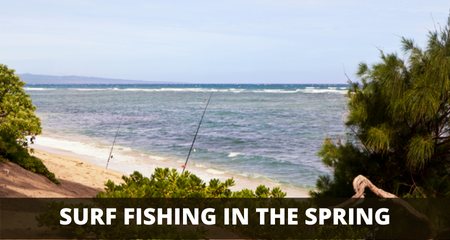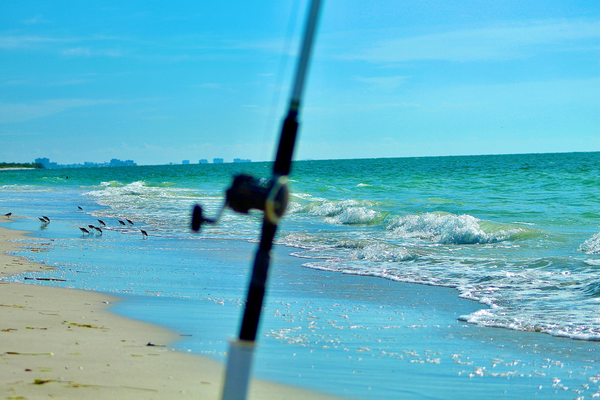Surf Fishing In Spring (3 Things You Need To Know)
UPDATED 17 MAY 2023
by Robert Ceran
I’ve been fishing the beaches of the Outer Banks for half a century, and during that time I’ve witnessed the beginning of the spring surf fishing season as early as the first week of March.
In the past, we were able to observe a fantastic quantity of large croakers, gigantic bluefish, large red drum, and gray trout that weighed between two and three pounds.
These species are no longer seen in the great numbers that we were accustomed to seeing since the times have changed.

Now, the beginning of the season is traditionally marked by the emergence of dogfish and skates, who are quickly followed by blow toads, sea mullet, puppy drum, and little bluefish.
However, the fishing in the spring along the coast can be phenomenal, and is well worth a trip.
Don’t rely too much on the calendar
Fish don’t look at calendars; their migrations are determined by the weather and the temperature of the water, and the same fish won’t travel into our seas until the water temperature is appropriate for them to do so.
When the water temperature hits the mid-fifties, seasoned surf anglers are ready to go to the beach and cast their lines.
Warm water often begins to appear in the waters off the coasts of Hatteras and Ocracoke Islands in the latter half of March or the first week of April.
The northern beaches warm up more slowly.
Pay attention to weather and water temperatures
When it comes to successfully catching fish in the surf, the temperature of the water, the weather, and the location are all crucial pieces of the jigsaw.
The fluctuations of the Gulf Stream have the potential to have a direct impact on the water near the coasts of Ocracoke and Hatteras Islands.
Along these southern-facing beaches, the water temperature will rise as a direct result of the warm days and nights that are accompanied by southerly winds.

It is also possible for the water temperature to rise dramatically whenever a warm water eddy breaks away from the primary currents carried by the Gulf Stream and is then brought closer to land by a wind that is blowing from the south.
It is not unusual for the water temperature of the ocean to be ten degrees warmer near Cape Point in the month of April than it is in Oregon Inlet, which is sixty miles to the north of Cape Point.
Expect fewer species when surf fishing in spring
Surfcasters can find plenty of fish to stretch their line on in the spring, from trophy-sized red drum to the diminutive sea mullet.
Although spring does not offer the same variety of species that we see during the peak of the fall surf fishing season in October and November, surfcasters can still find plenty to stretch their line on.
Keep an eye out for the smaller species to surface first, which often happens from the southern end of Hatteras Island all the way down to Ocracoke.
The most commonly caught species in the spring
Skates and dogfish aren’t exactly the most well-liked species of fish, but the fact that they show up in the surf in the springtime is a sure indicator that something exciting is about to take place.
Croakers, sea mullet, and blow toads will begin to seep into the surf at around the same time, and it is possible that they may be mixed up with doggies and skates.
When you add red drum, bluefish, little gray trout, and flounder to this mix, you have the makings of some excellent fishing opportunities.
Catching huge red drum in the spring surf
Red drum are the dominant predators in the spring surf and can grow to be as heavy as fifty pounds or more.
In the spring, the South Beach of Hatteras Island, False Point close to Hatteras Inlet, and the southern edge of Ocracoke Island are going to be your best bets for catching huge red drum.
This is also true for the other types of fish. On the other hand, Cape Point, which is located close to Buxton, is frequently ground zero for the finest drum bites.
Where to find red drum in spring
Large groups of drum cluster in the areas of shallow water along the entrances of the inlets of Hatteras and Ocracoke, as well as along the perilous Diamond Shoals.
The best chance of catching them is from a boat, but if there is a strong breeze from the southeast or southwest, they will most likely end up on the beach at The Point.
Drum prefer to eat when it’s dark out, so the combination of a stiff breeze from the southeast and a rising tide in the evening is a dream come true for those who fish for drum in the area.
The beach close to Hatteras Inlet is a good place to go when you need a break from the busy throng in Cape Point.
The shoals, shallow water, and sandbars, which are located in close proximity to deep water, create the proper mix that functions as a magnet that attracts feeding drum, and the same weather conditions that produce at Cape Point will frequently cause a drum bite here.
Spring surf fishing for sea mullet
There are a lot of other things you may do besides the difficult process of landing a trophy red drum.
The fishing for sea mullet in the spring may be quite good. They are one of the first species of fish to show up in the spring waves in the Outer Banks.
When fishing for them with two-hook bottom rigs and tiny hooks size 4, they will readily take small pieces of squid, shrimp, or bloodworms as bait.
The South Beach from Cape Point down to the Buxton Campground and from beach access Ramp 55 down to Hatteras Inlet are usually hot places for catching mullet weighing between three quarters of a pound and one and a half pounds.
Rigging for bottom-feeding fish in the surf
It is not difficult to catch sea mullet or other bottom-feeding fish like spot or croaker with fairly simple fishing rigs and basic tackle.
A significant number of fish are caught on the ever-popular two-hook bottom rig, which utilizes long shank spinner blade hooks in sizes ranging from #2 to #4.
This rig has been created for the purpose of fishing in the surf for sea mullet, spot, and pompano.
The most important versions of the 2-hook bottom rig
There are two main versions of the two-hook bottom rig:
The first one has two little cork floats that have been painted in brilliant colors.
The second one has two hooks with a gold finish, and each one has a little plastic bead that is connected to the point of the hook.
You may use small pieces of bloodworm, shrimp, or even fresh mullet cut into cubes as bait for them.
Spring surf fishing for bluefish
Bluefish, which may weigh anything from a half pound to several pounds, are also known to put on a nice show during the springtime.
The most effective rigs for bluefish are bottom rigs with strips of fresh mullet or two-hook fireball rigs baited with mullet strips.
It is possible to encounter bluefish eating aggressively in the surf early in the morning or late in the afternoon, with bait pouring down on them and birds working over them.
When fishing in these conditions, you should use a metal lure like a Hopkins, Kastmaster, Gator, or Stingsilver.
When fishing for blues under three pounds, a wire leader is not required; however, when fishing for blues above three pounds, you should consider using a short length of wire in front of the lure to reduce bite-offs.
Research local weather conditions before you go fishing
The fishing in the spring may be somewhat unpredictable, much like the weather.
It’s possible that a cold front accompanied by strong winds from the north may force the fish to suffer from a severe case of lockjaw, which would make fishing impossible for a few days
A local tackle store on Hatteras or Ocracoke Island is your best chance for getting the most up-to-date information on both the weather and the fishing.
If you want to get the most out of your fishing trip to the Outer Banks, you should give one of these shops a call before you leave.
